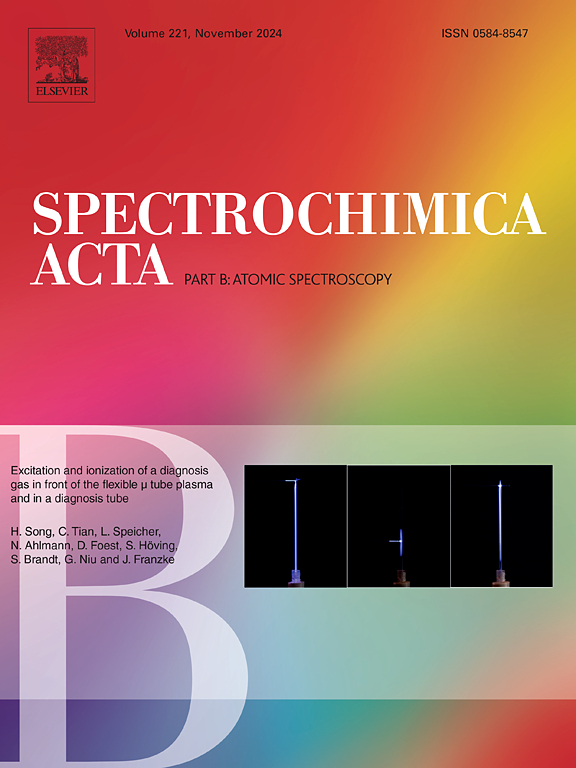用Neoma质谱/质谱进行高精度Rb-Sr同位素分析:激光烧蚀增强原位地质年代学
IF 3.2
2区 化学
Q1 SPECTROSCOPY
引用次数: 0
摘要
多收集器电感耦合等离子体质谱(MC-ICP-MS)与串联质谱(MS/MS)技术的发展,结合激光烧蚀系统(LA),为原位铷锶(Rb-Sr)地质年代学带来了重大进展。本研究探讨了Neoma MS/MS仪器在原位Rb-Sr测年中的潜力,采用溶液和LA分析,重点是优化仪器参数和评价参考物质。我们系统地评估了Ar+的去除,Focus Lens 2电压对Sr同位素分析精度的影响,以及反应模式在消除等压干扰方面的有效性。LA分析结果表明,Neoma MS/MS能够实现高精度的原位Rb-Sr同位素比值测量,在标准玻璃中87Rb/86Sr和87Sr/86Sr比值的外部精度分别优于1.9%和0.036%的相对标准偏差(RSD)。进一步评估了云母-镁标准物质的均匀性,其Rb-Sr等时年龄的间隔RSD为0.17%,表明在9个分析阶段中具有良好的年龄均匀性。同样,天然白云母ZMT04的Rb-Sr等时年龄的期间RSD为0.69%,其Rb-Sr等时年龄为1778.8±4.9 Ma (2 s, n = 180),在不确定度范围内与报道的Ar-Ar年龄(1772.2±2.7 Ma, 2 s)一致,证实了其作为Rb-Sr定年监测参考物质的适用性。这些发现突出了Neoma MS/MS在提高原位Rb-Sr测年精度、微观尺度调查和揭示单个矿物中复杂的年龄分带模式方面的潜力。本文章由计算机程序翻译,如有差异,请以英文原文为准。

High-precision Rb-Sr isotope analysis with Neoma MS/MS: Enhancing in situ geochronology by laser ablation
The development of multi-collector inductively coupled plasma mass spectrometry (MC-ICP-MS) with tandem mass spectrometry (MS/MS) technology has brought significant advancements for in situ Rubidium‑strontium (Rb-Sr) geochronology, coupled with a laser ablation system (LA). This study investigates the potential of high-precision in situ Rb-Sr dating by the Neoma MS/MS instrument, using both solution and LA analysis, with a focus on optimizing instrumental parameters and the evaluating reference materials. We systematically assess the removal of Ar+, the influence of Focus Lens 2 voltage on Sr isotope analytical accuracy, and the effectiveness of reaction mode in eliminating isobaric interferences. Results of LA analyses demonstrate the capability of Neoma MS/MS to achieve high-precision in situ Rb-Sr isotope ratio measurements, with external precisions better than 1.9 % and 0.036 % relative standard deviation (RSD) for 87Rb/86Sr and 87Sr/86Sr ratios in standard glasses, respectively. The homogeneity of the Mica-Mg reference material is further assessed, with an inter-session RSD of 0.17 % for its Rb-Sr isochron age, demonstrating good age homogeneity across nine analytical sessions. Similarly, the natural ZMT04 muscovite yielded an inter-session RSD of 0.69 % for its Rb-Sr isochron age, and its Rb-Sr isochron age of 1778.8 ± 4.9 Ma (2 s, n = 180) is consistent with the reported Ar-Ar age (1772.2 ± 2.7 Ma, 2 s) within the uncertainty, confirming its suitability as a monitor reference material for Rb-Sr dating. These findings highlight the potential of the Neoma MS/MS in enhancing the precision of in situ Rb-Sr dating, for micro-scale investigations and revealing intricate age zonation patterns within individual minerals.
求助全文
通过发布文献求助,成功后即可免费获取论文全文。
去求助
来源期刊
CiteScore
6.10
自引率
12.10%
发文量
173
审稿时长
81 days
期刊介绍:
Spectrochimica Acta Part B: Atomic Spectroscopy, is intended for the rapid publication of both original work and reviews in the following fields:
Atomic Emission (AES), Atomic Absorption (AAS) and Atomic Fluorescence (AFS) spectroscopy;
Mass Spectrometry (MS) for inorganic analysis covering Spark Source (SS-MS), Inductively Coupled Plasma (ICP-MS), Glow Discharge (GD-MS), and Secondary Ion Mass Spectrometry (SIMS).
Laser induced atomic spectroscopy for inorganic analysis, including non-linear optical laser spectroscopy, covering Laser Enhanced Ionization (LEI), Laser Induced Fluorescence (LIF), Resonance Ionization Spectroscopy (RIS) and Resonance Ionization Mass Spectrometry (RIMS); Laser Induced Breakdown Spectroscopy (LIBS); Cavity Ringdown Spectroscopy (CRDS), Laser Ablation Inductively Coupled Plasma Atomic Emission Spectroscopy (LA-ICP-AES) and Laser Ablation Inductively Coupled Plasma Mass Spectrometry (LA-ICP-MS).
X-ray spectrometry, X-ray Optics and Microanalysis, including X-ray fluorescence spectrometry (XRF) and related techniques, in particular Total-reflection X-ray Fluorescence Spectrometry (TXRF), and Synchrotron Radiation-excited Total reflection XRF (SR-TXRF).
Manuscripts dealing with (i) fundamentals, (ii) methodology development, (iii)instrumentation, and (iv) applications, can be submitted for publication.

 求助内容:
求助内容: 应助结果提醒方式:
应助结果提醒方式:


